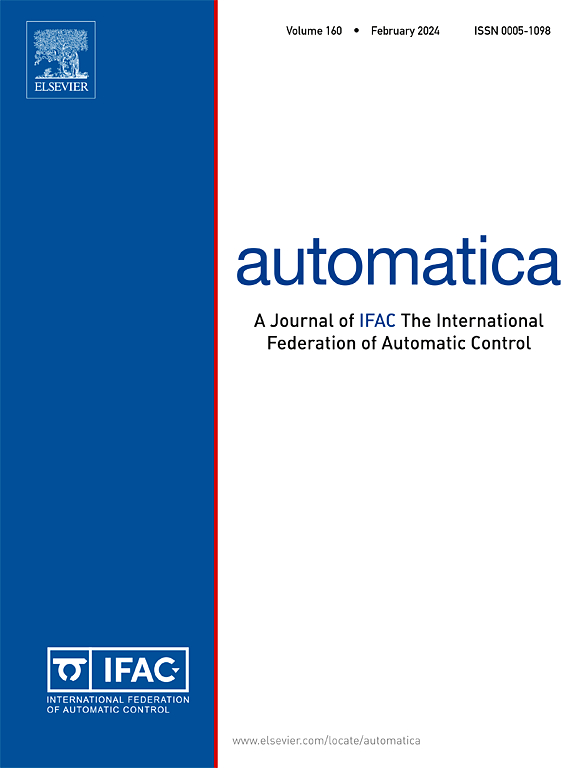Generalizations of data-driven balancing: What to sample for different balancing-based reduced models
IF 5.9
2区 计算机科学
Q1 AUTOMATION & CONTROL SYSTEMS
引用次数: 0
Abstract
The quadrature-based balanced truncation (QuadBT) framework of Gosea et al. (2022) is a non-intrusive reformulation of balanced truncation (BT), a classical projection-based model-order reduction technique for linear systems. QuadBT is non-intrusive in the sense that it builds approximate balanced truncation reduced-order models entirely from system response data, e.g., transfer function measurements, without the need to reference an explicit state-space realization of the underlying full-order model. In this work, we generalize the QuadBT framework to other types of balanced truncation model reduction. Namely, we show what transfer function data are required to compute data-driven reduced models by balanced stochastic truncation, positive-real balanced truncation, and bounded-real balanced truncation. In each case, these data are evaluations of particular spectral factors associated with the system of interest. These results lay the theoretical foundation for data-driven reformulations of the aforementioned BT variants. Although it is not yet clear how to compute or obtain these spectral factor data in a practical real-world setting, examples using synthetic (numerically evaluated) transfer function data are included to validate the data-based reduced models.
数据驱动平衡的概括:对不同的基于平衡的简化模型进行什么采样
Gosea等人(2022)的基于正交的平衡截断(QuadBT)框架是平衡截断(BT)的非侵入式重新表达,平衡截断(BT)是一种经典的基于投影的线性系统模型降阶技术。QuadBT是非侵入性的,因为它完全从系统响应数据(例如传递函数测量)构建近似平衡截断降阶模型,而不需要引用底层全阶模型的显式状态空间实现。在这项工作中,我们将QuadBT框架推广到其他类型的平衡截断模型约简。也就是说,我们展示了通过平衡随机截断、正实平衡截断和有界实平衡截断来计算数据驱动的简化模型所需的传递函数数据。在每种情况下,这些数据都是与感兴趣的系统相关的特定光谱因子的评估。这些结果为上述BT变体的数据驱动重组奠定了理论基础。虽然目前尚不清楚如何在实际的现实环境中计算或获得这些谱因子数据,但包括使用合成(数值评估)传递函数数据的示例,以验证基于数据的简化模型。
本文章由计算机程序翻译,如有差异,请以英文原文为准。
求助全文
约1分钟内获得全文
求助全文
来源期刊

Automatica
工程技术-工程:电子与电气
CiteScore
10.70
自引率
7.80%
发文量
617
审稿时长
5 months
期刊介绍:
Automatica is a leading archival publication in the field of systems and control. The field encompasses today a broad set of areas and topics, and is thriving not only within itself but also in terms of its impact on other fields, such as communications, computers, biology, energy and economics. Since its inception in 1963, Automatica has kept abreast with the evolution of the field over the years, and has emerged as a leading publication driving the trends in the field.
After being founded in 1963, Automatica became a journal of the International Federation of Automatic Control (IFAC) in 1969. It features a characteristic blend of theoretical and applied papers of archival, lasting value, reporting cutting edge research results by authors across the globe. It features articles in distinct categories, including regular, brief and survey papers, technical communiqués, correspondence items, as well as reviews on published books of interest to the readership. It occasionally publishes special issues on emerging new topics or established mature topics of interest to a broad audience.
Automatica solicits original high-quality contributions in all the categories listed above, and in all areas of systems and control interpreted in a broad sense and evolving constantly. They may be submitted directly to a subject editor or to the Editor-in-Chief if not sure about the subject area. Editorial procedures in place assure careful, fair, and prompt handling of all submitted articles. Accepted papers appear in the journal in the shortest time feasible given production time constraints.
 求助内容:
求助内容: 应助结果提醒方式:
应助结果提醒方式:


